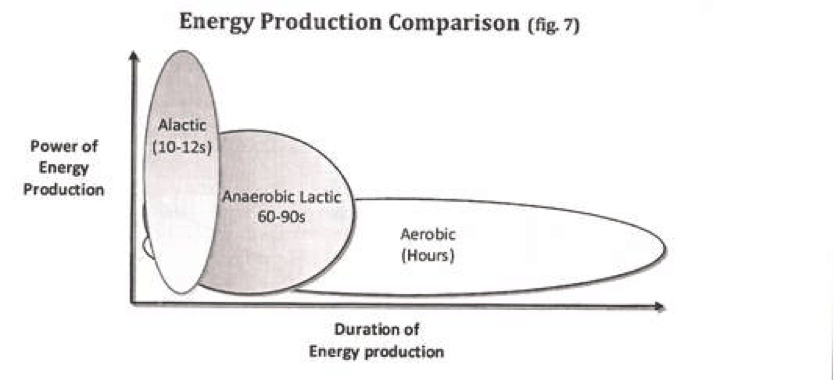Today, I’m going to introduce you to the Anaerobic Alactic (ATP-PC) energy system. I’m going to explain what it is, why you need to pay attention to it, and how to implement it into your own training
This is part two of our three-part series introducing you to the three energy systems. If you haven’t read the aerobic energy system article, I would suggest reading that first before continuing. You can find it here: The Aerobic Energy System
Table of Contents
In order to move from a fitness enthusiast to an advanced everyday athlete, you have to start thinking in terms of energy system training. Move away from “sets, reps, rest,” and decide which energy system you are training each training day and ask yourself why.
Human beings are designed to be aerobic. The more aerobic we are, the more resilient we can be in life. That doesn’t mean we should forget about the anaerobic energy systems: the alactic and lactic systems.
However, contrary to popular belief, you need to earn the right to train anaerobically, which means progressing first through the aerobic continuum and actually being physically strong enough to participate fully. This will allow you to go deep enough into your central nervous system to elicit the correct response.
We prioritize the aerobic energy system above all other energy systems because it is so important. It’s the foundational aspect of any training program, but we can build a robust aerobic system alongside your alactic system.
The Three Energy Systems (Recap)
As a quick reminder, there are three energy systems. The body draws on all three, regardless of the type of effort you put in. They merely change in the amount of energy they contribute depending on the duration and intensity of the effort.
They are the:
- ATP-PC system or alactic system
- Anaerobic glycolysis or lactic acid system
- Aerobic system
Here’s how they work:
- ATP (Adenosine tri-phosphate) is the only energy source for all bodily functions and movements.
- When ATP is used for energy production, it must be replenished.
- The body can replenish ATP aerobically or anaerobically.
- The aerobic system replenishes ATP with the presence of oxygen.
- The alactic and lactic systems replenish ATP without the presence of oxygen.
In terms of working timeframes, we’re looking at:
- Alactic = activities < 10 seconds
- Lactic = activities lasting approximately 40–60 seconds
- Aerobic = activities lasting hours
Alternatively, the visual below might help you have a better understanding.

What Is the Anaerobic Alactic Energy System?
To compare, anaerobic work is without the presence of oxygen; alactic work is without the presence of lactate. The alactic energy system is synonymous with sprint training, weight training, and resistance training. It can be described as tackling absolute strength adaptations or one-rep max lifts and explosive power. The timeframe of work in this energy system lasts up to about 10 seconds.
In short, it’s your body’s simplest, most immediate and powerful energy source. Think explosive energy—an incredible amount of stored energy in the body, released in a very short time.
To improve absolute strength, explosive power and reach true physical potential, you can’t overlook the importance of the alactic system. It’s the system of choice for explosive athletics such as power lifters, Olympic weight lifters, and sprinters.
There are three main reasons for training the alactic energy system:
- Mechanical adaptation
- Hormonal effects
- Coordination of both the intramuscular (fibers) and inter-muscular (muscles) in the body
The strength training aspect has a huge part to play in daily life, and it’s an incredibly important energy system that should not be neglected. We may prioritize the aerobic system, but we never forget the alactic system in terms of resistance training. It’s a vital component that goes hand in hand with the aerobic system.
Anaerobic Alactic Power
Inside the anaerobic alactic system, we also have Alactic Power. Alactic power is the starting point for all anaerobic training responses. This is beyond resistance training. Think of alactic power as faster contractions, the sprints.
Alactic power is purely about releasing all stored energy in a timeframe of 0–10 seconds. It’s unsustainable work. This is not resistance training. As compared to resistance training, the absolute speed and the metabolic effect is higher.
This is the highest amount of power achieved in energy system development training. You will see a tremendous drop in power output if you attempt to sustain this effort.
In our model of training, in order to train true alactic power, you need a certain pre-requisite of strength and aerobic capacity.
Here are our minimum strength standards that must be met prior to training alactic power:
Women
- 1.25 x bodyweight deadlift x 5 reps
- Bodyweight back squat x 5 reps
- 3 x pull-ups
- 3 x dips
- 75% bodyweight farmers carry – 90 seconds
Men
- 1.5 x bodyweight deadlift x 5 reps
- Bodyweight back squat x 5 reps
- 5 x pull-ups
- 5 x dips
- 75% bodyweight farmers carry – 90 seconds
In addition to our strength standards, clients must have also progressed through our aerobic continuum and be able to clearly demonstrate the ability to perform tasks for 60+ minutes and perform prolonged faster contractions demonstrating clear repeatability.
This can sometimes take years to progress. Anaerobic training, to truly elicit the correct dose response, can take years to reach. This isn’t for beginners. This isn’t even for most intermediates. (Yet, mainstream media continues to talk about HIIT. It’s a real bugbear of mine.)
Examples of anaerobic power work can include assault bike, rowing, sprinting, and pushing a sled.
If people don’t have the prerequisite strength to elicit the dose-response of alactic power training, they will recover much quicker relative to the timeframe of work performed. This means that they are not releasing stored energy to the level needed and not going deep enough into the CNS.
If you can do 10 seconds of max intensity assault bike sprints, rest a few seconds, and go again, you’re not strong enough to be doing this work.
Anaerobic alactic power training is intended to increase the repeatability of power. This is the starting point for extending power into longer timeframes for more potent stress adaptation, increasing metabolic effects, and proving a boost to the aerobic system.
But without prerequisite strength levels and a poor aerobic system, alactic power training is a pointless task and will not help you reach full athletic potential. In truth, it shouldn’t even be considered an option for over 90% of individuals. Earn the right to train anaerobic power.
How Do We Train the Alactic Energy System?
We can open up a can of worms diving into this. As noted above, we have traditionally weightlifting and resistance training, and we can start to develop alactic power and begin the anaerobic continuum that leads to lactic work.
The honest answer is it varies.
It varies from person to person, and it all comes down to the individual’s assessments. We need to ask the following questions:
- Are they strong enough? Yes/No
- Do they have a good foundation in aerobic training? Yes/No
If the answer is no to strength, we need to get them stronger while building their aerobic base simultaneously.
If the answer is yes to strength but no to aerobic training, the answer is once again no. Let’s continue to build their aerobic base and progress through the aerobic continuum.
If the answer is yes to both and the needs of the client dictate that we do anaerobic power work, only then do we go into anaerobic power work.
Most people simply do not need to do this type of anaerobic work. It is unsustainable and puts the body into survival mode. We simply do not need to stress the average person out even more than they already are. It plays havoc with their body and will certainly not help them reach their goals any faster. In fact, it often has the opposite effect.
Our Philosophy to Strength Training
We follow the traditional strength continuum model:
Absolute Strength –> Strength Speed –> Speed Strength –> Absolute Speed
With 90% of our clients who are interested in health and longevity, most of our time is spent with absolute strength. We start by working on muscular endurance and gradually build towards maximal contractions.
We have seven fundamental human movements:
- Locomotion
- Push
- Pull
- Hinge
- Squat
- Rotate
- Anti-Rotate
Novices will always perform each of the seven movements in each of their prescribed alactic workouts, mostly in a circuit fashion. The goal here is to build muscular endurance that leads towards more maximal contractions.
Intermediates will start to perform more intense contractions that require much more taxing movements and place higher demands on the central nervous system, but still combine full body movements as we continue to develop muscular endurance.
Advanced individuals may be able to train for absolute strength multiple times a week, with each day’s focus on a specific movement, such as push or pull. They have earned the right to progress to this stage as they are now able to go deeper into the nervous system, having built a foundation through muscular endurance.

Our Philosophy to Alactic Power Development
Remember, this is only done if people have the prerequisite absolute strength and adequate aerobic capacity. Nearly 90% of the people we work with don’t train in this environment. And we certainly don’t prescribe it to people who are highly stressed. It’s not sustainable work.
When working the anaerobic continuum, we progress from power to endurance. That’s our default model. The aerobic continuum is the opposite way around, endurance to power.
Similar to developing the aerobic system, we look for repeatability in sets. This is key to developing the anaerobic system. We try to flirt with failure but avoid burn out. That’s the secret.
We do up to 10 seconds work, maximum, so we tend to choose cyclical methods (assault bike, rower, etc.) to perform this. Sometimes this can be stand-alone work, or we often train this after a lighter weights session in order to avoid fatigue if this is the current priority of development.
A sample anaerobic alactic power session would be:
- Assault bike: Max calories in 10 seconds
- Rest
- Repeat
- Can you hit the same number of calories in 10 seconds? Yes/No?
If yes, repeat. Continue until failure.
No. You’re done for the day.
Over time, we’re looking to progress this to a higher number of working sets, but it takes time and patience and working in conjunction with your central nervous system.
We’re avoiding burn out at all costs. Why? Because the brain has one function. Survival. Anaerobic work is unsustainable work, and the brain doesn’t like it.
Closing Thoughts
The anaerobic alactic energy system is an extremely important energy system. We may prioritize the aerobic system first for health and longevity, but we certainly do not forget or underestimate the importance of this system.
When programming for everyday athletes, we predominantly look at strength development. However, as you now know, starting to develop alactic power allows us to transition into lactic work and the lactic energy system.
We only start developing alactic power when someone demonstrates the pre-requisite strength and has sufficiently progressed through the aerobic continuum.
Are you starting to love energy systems as much as I do? There’s an art and a science to energy system training. I hope you’re starting to see why it’s so important and that you’re beginning to put all the puzzle pieces together.
Next up, is the anaerobic lactic energy system.
FAQ
What is the Anaerobic Alactic Energy System?
The anaerobic alactic energy system, also known as the ATP-PC system or phosphagen system, is one of three energy systems the body uses to produce energy for muscle contractions. It operates without the need for oxygen and uses the compounds ATP (adenosine triphosphate) and PC (phosphocreatine) stored in the muscles to produce energy. It provides a rapid energy source but is quickly depleted, typically within 10 to 20 seconds of maximal effort.
Why is the Anaerobic Alactic Energy System Important?
The anaerobic alactic system is critical because it provides immediate energy at the onset of activity and during short, intense bursts of activity such as sprinting or heavy weight lifting. Understanding this energy system is essential for athletes involved in sports that require quick bursts of maximum effort.
How Can You Train the Anaerobic Alactic Energy System?
You can train the anaerobic alactic energy system through short, intense bouts of exercise, such as sprints, high-intensity interval training (HIIT) with very short intervals, or heavy resistance training. Such training stimulates adaptations that increase the body’s stores of ATP and PC, enhancing the capacity and efficiency of the anaerobic alactic system. Rest periods between efforts should be long enough to allow for almost complete recovery, as the goal is maximum intensity.
What Are 5 Anaerobic Lactic System Activities?
Anaerobic lactic system activities often include high-intensity workouts that last up to 90 seconds. Examples of such activities are 400-meter sprints, repeated stair climbing, boxing, and High-Intensity Interval Training (HIIT) workouts.
What is the 10 Anaerobic A Lactic System?
The term “10 Anaerobic A Lactic System” seems to be a misunderstanding. The Anaerobic Alactic System, also known as the ATP-CP system, is one of the energy systems that powers high-intensity, short-duration activities like a 10-second sprint or a heavyweight lift.
What is Anaerobic A Lactic System?
The Anaerobic Alactic System, also known as the ATP-CP energy system, is responsible for producing energy quickly for high-intensity activities of short duration (usually up to 10 seconds). It uses stored ATP (Adenosine Triphosphate) and CP (Creatine Phosphate) in the muscles for energy and does not produce lactic acid as a byproduct.
What is an Example of a Lactic System?
The Lactic Acid System, also known as the Anaerobic Lactic System, is an energy system that provides power for medium to high-intensity activities ranging from about 10 seconds to 2 minutes. Examples of activities that utilize this system include middle-distance running (400m or 800m), swimming sprints, or high-repetition weight lifting.


What a great read, thank you.
You’re welcome Jen! Anything else we can write about to help you?
Hi. Thanks for a good article. Could you please answer this question for me:
What is the recovery time for the anaerobic alactic system leaving muscles out of the equation.
To clarify: Supposing one performed a session of sprint drills in the morning. Muscle recovery would be the limiting factor as to why one wouldn’t repeat the same session that same afternoon. But would there be any benefit to training the alactic system again that day with a differnt exercise such as rowing or swimming, or does the anaerobic alactic system itself require more recovery time?
Thanks in advance.
Matt
Hey Matt,
Thanks for the nod on the article!
Alright, straight to your question: that anaerobic alactic system, or the ATP-PC system, is like a quick-fire rocket – burns bright but resets pretty swiftly. Think a few minutes to maybe 10, if you’re feeling good and keeping on top of things like food and water.
But here’s the kicker – even if that system bounces back quickly, doubling down on two alactic sessions in one day? I’d pump the brakes on that. It’s not just about the muscles, but your central nervous system (CNS) could feel the strain, and trust me, you don’t want to overcook that.
And even if you’re thinking of switching things up – sprints in the morning, rowing in the afternoon – I’d still advise some caution. From a personal stance, I’d recommend spacing out those alactic sessions with at least 48 hours in between. Gives your body and CNS a proper breather.
Hope that clears things up a bit. Give me a shout if you’ve got more queries!
Cheers, James
Wow, so glad I found your article. Suddenly everything makes sense. I’m a cyclist with a very strong sprint but low aerobic power. I’ve always thought there were just 2 primary systems, Anaerobic (lactic) and Aerobic. Now I think I can better train to work on all 3 systems.
Thanks,
Paul